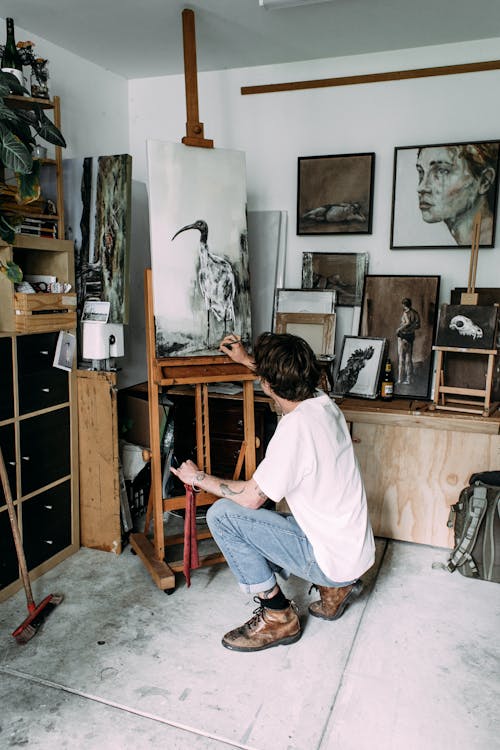13 Things to Keep in Mind When Writing Your Portfolio Introduction

Why Your Portfolio Intro is Kind of a Big Deal
Think of your portfolio introduction as your front door. Before anyone browses your work, they meet your words. And those words can either invite someone to step inside or make them scroll right past. Whether you’re an emerging artist or simply updating your online presence, your introduction isn’t just filler. It’s your first impression, your handshake, your hello-I’m-here moment. It frames your work with intention and gives your viewer a soft place to land before they dive into the visuals.
Writing a compelling introduction is about more than just saying what you do. It’s about grounding your viewer. Helping them understand where you’re coming from and where your work wants to go. When done well, your intro can create instant emotional connection. When done poorly, it can make your work feel distant or inaccessible. So before you worry about the layout or photo quality, invest some time into crafting a paragraph that feels like an open door.
Ditch the Fancy Talk, Say It Like You Mean It
Forget the art speak. You don’t have to sound like an academic or a gallery press release. In fact, sounding like that often does more harm than good. Readers, curators, and fellow artists want to know the human behind the work, not just your list of exhibitions or mediums. What makes your story yours? What can only you say? That’s the version of you we want in your intro. Authenticity matters more than formality. People can feel the difference.
Instead of presenting yourself in the third person or defaulting to overused phrases, try writing how you speak. Imagine you’re introducing yourself at a studio visit. What would you say if you weren’t trying to impress, but instead to connect? Maybe your practice began out of frustration or grief. Maybe it’s playful and filled with humor. Maybe you’re still figuring things out. All of that is welcome. All of that is you. Your story is already interesting enough without dressing it up.
Hook Us With Your First Line
Your opening line should feel like a spark. It doesn’t need to be overly poetic or mysterious, but it should carry your voice and a sliver of your artistic spirit. It’s the line that makes someone pause. The one that says, “Wait, I want to hear more.” It could be unexpected. Vulnerable. Even a little strange. But it should come from a place that feels true.
You don’t need to force a hook, sometimes it’s a sentence you almost didn’t write down that turns out to be the most magnetic. For example, “I only started painting because I ran out of words during a hard year” says more than a polished elevator pitch ever could. If a sentence feels a little scary to share, it’s probably close to something honest. And honesty is what makes readers lean in.
Consider beginning with a question you’ve always asked. Or a memory that shaped your creative life. Maybe the first thing you ever made that felt real. Or the emotion that keeps you making. For instance, you could write: “I once made an entire sculpture out of broken jewelry because I couldn’t throw away what hurt.” That one sentence already gives us texture and mood. It builds curiosity, and curiosity keeps readers reading.
Tell Us What You’re Drawn To
Your materials matter, but so do your motivations. A strong introduction goes beyond the “what” and into the “why.” What do you return to again and again? Is there a visual pattern or a subject that keeps surfacing? Do you create from memory, from protest, from joy? Help us understand what pulls you in as an artist. That’s how we begin to connect not just with your work, but with your worldview.
Sometimes, your inspirations aren’t tidy or obvious, and that’s okay. You don’t need to package your curiosity neatly. Maybe you’re inspired by late-night dreams, family recipes, or ghost stories. The point isn’t to sound impressive. It’s to give a glimpse into what sparks you alive. Those inner pullings are where the real stories are hiding. Let your intro be where some of them begin.

Think about your obsessions. The things you notice that others don’t. Maybe you’re fascinated by rusted fences, shadow patterns on old buildings, or forgotten languages. Share those curiosities. They’re not random, they’re often the root of your visual language. When you tell us what you’re drawn to, we begin to see your work not just as product, but as process. We understand what’s alive behind the canvas or camera.
Long Enough to Matter, Short Enough to Read
There’s a sweet spot when it comes to length. Too short, and it feels like an afterthought. Too long, and it risks losing the reader. Aim for somewhere between 150 and 300 words, just enough to introduce us without overwhelming. You want depth, but also clarity. Think of it as an elevator pitch with soul.
One trick to keeping it tight but impactful? Write it all out first, without editing yourself, then highlight just the sentences that truly sound like you. Trim anything that feels like padding. You’ll end up with a lean, honest introduction that still says something real. Think of it like sculpting. The raw material matters, but what you carve away reveals the shape.
Break your intro into small, digestible paragraphs. Use line breaks if you need space to breathe. Avoid long blocks of text. And remember, this is just one part of your portfolio. You don’t need to say everything here. You can always include a longer artist statement or process note elsewhere. This is your welcoming mat. Keep it open, inviting, and easy to step onto.
Stay Present: Speak From Who You Are Now
Your portfolio is alive, and so is your voice. Don’t write your introduction as if you’re stuck in the past. Speak from the artist you are right now, not the one you were five years ago, or the one you think people expect. If you’re in a season of experimentation, say that. If your work feels chaotic but honest, let us know. The more you reflect your current truth, the more compelling your intro will feel.
Think of your intro like a creative snapshot, not a final draft. It’s allowed to shift with you. If you’re between styles, mediums, or even motivations, name that honestly. You don’t need certainty to write something meaningful. You just need awareness of where you are and enough courage to share it. That honesty gives your intro soul, even in uncertainty.
It’s easy to get caught up in trying to sound “professional,” but often that creates distance. People connect with present-moment honesty. If you’re currently obsessed with one material or breaking away from past work, mention that. This shows growth, self-awareness, and depth. And it makes your practice feel relevant and alive.
Use Words That Sound Like You, Not a Dictionary
Let your writing reflect your tone, rhythm, and vocabulary. If your art is soft and contemplative, your words can be gentle and fluid. If your work is loud and expressive, let your sentences carry that same energy. There’s no rule that says you have to write in a certain style. Let your writing feel like your work.
Your introduction doesn’t have to follow traditional grammar or structure if that’s not your natural rhythm. If you speak in fragments, pause a lot, or write like you’re journaling, keep that. Art is personal, and your intro should carry the same fingerprints. If your reader can hear your voice in the text, you’re doing it right
Avoid generic terms or overly intellectual phrasing unless that’s how you naturally speak. Replace “investigates” with “wonders” or “responds.” Instead of “explores themes of,” try “I keep returning to.” Your words don’t have to be fancy to be powerful. They just have to be yours. Make them feel lived in, like they belong to you and your work.
Sprinkle in Some Personality
Don’t be afraid to let your quirks show. Maybe you’re most creative when listening to thunderstorms. Maybe your studio is a mess, but that chaos sparks ideas. Maybe your first art piece was made with dried pasta and glitter. These little bits of personality don’t make your intro unprofessional, they make it unforgettable.
Small, specific details can bring your intro to life. Like how your dog chews your brushes. Or how you only paint when it rains. These aren’t distractions. They’re grounding. They make your reader feel like they know you a little, and that trust makes your work more approachable. In a sea of polished bios, a little personality goes a long way.

Your story is part of your art. Letting that show creates intimacy. It builds a bridge between your reader and your process. We want to know what lights you up. What makes you laugh. What you’re still trying to figure out. These aren’t distractions. They’re clues into who you are, and why your work matters.
Say It With a Visual Metaphor
When language feels limiting, metaphors can set you free. Use imagery to describe what your art feels like to make. Is it like piecing together a dream? Like shouting underwater? Like digging for fossils? Visual metaphors don’t just sound pretty, they help your viewer feel your world more fully.
Try playing with sensory language. If your work feels like fog lifting or like velvet being torn, say that. Your viewer might not know your medium, but they’ll know that feeling. When done well, a metaphor doesn’t obscure your point, it anchors it. It says, “Come feel this with me,” and that kind of invitation is powerful.
Metaphors give dimension to your voice. They bridge the space between concept and emotion. And they help your introduction stand out from others. A single metaphor can stay with a reader long after they’ve left your page. Don’t worry about being too poetic. If it helps express what words alone can’t, go for it.
Say Goodbye to the Art School Voice
It’s tempting to sound like an academic paper or gallery wall text. But resist the urge to write in a way that feels distant or overly polished. The “art school voice” often strips away your individuality. You don’t need to impress anyone with your vocabulary. You need to connect.
You’re not being graded, you’re being read. And reading something that feels human is always more compelling than something technically correct but emotionally hollow. You don’t have to dumb things down. Just simplify where needed and let your own voice do the heavy lifting. The reader isn’t looking for credentials, they’re looking for connection.
Instead of “engaging with themes of spatial disruption and socio-political fragmentation,” try: “I’m making work that feels like a protest and a prayer. It’s full of tension and softness, grief and grit.” That sentence might not land in a museum guidebook, but it lands in a reader’s heart. And that’s more important here.
Why You Make Art Matters More Than What You Make
We care that you paint or sculpt or design, but we care even more why you do it. What’s underneath your work? What are you chasing or healing or building? Your portfolio is a collection of what you make. Your intro is where we get to understand what drives you.
Your medium might shift, but your “why” tends to stay steady. That inner compass, the one that leads you to create when no one’s watching, is often where the real power is. If you create to process grief, to celebrate joy, or to reclaim identity, share that. It doesn’t have to be dramatic to be real. Just honest.
Think of your work as a trail of breadcrumbs. Your introduction tells us what’s waiting at the end of the path. Maybe it’s memory. Maybe it’s justice. Maybe it’s joy. Whatever it is, let us feel the heartbeat behind the brushstrokes. That’s what will resonate most.
Remember You’re Writing for Humans
Sometimes, in trying to sound “professional,” we forget the reader is a person. Not a panel of judges. Not an algorithm. A human. Write like one. Speak clearly. Use warmth. Let your tone reflect your personality. And remember that not everyone reading your portfolio has an art background. That’s okay. Make your intro accessible.
If you’re ever unsure whether your intro sounds like you, try reading it out loud. If it feels stiff or distant when spoken, it probably needs softening. And if it feels like something you’d say to a friend at a cafe, you’re on the right track. Being human means being relatable, even in your portfolio. Especially in your portfolio.
Your goal isn’t to sound impressive. It’s to be understood. To be remembered. To invite someone into your world and make them want to stay. So write like you’re talking to someone who cares about your work, and trust that your real voice is enough.
Let a Non-Art Friend Read It First
Sometimes we’re too close to our own work to see it clearly. After writing your intro, share it with someone who isn’t an artist. A friend, a sibling, your neighbor. Ask them what stood out. What they felt. What confused them. Their feedback can be gold.
If they get what you’re saying and feel a connection, great. If they’re lost or confused, you may need to revise. The best introductions feel grounded and clear no matter who’s reading them. That doesn’t mean dumbing it down. It means lifting it up, so your meaning shines through.
Your Intro Grows Up with You, Update It
You’re not carving your introduction in stone. You can change it, rewrite it, or completely reinvent it as your practice grows. And you should. Every time you shift your medium, your focus, or your message, give your introduction a fresh look.
Don’t wait until you feel “ready” to rewrite it either. Even small updates, swapping one word for a better one, or shifting the tone to match your new work, can keep your introduction aligned with your current creative energy. Let it grow with you. Let it reflect where you’re going, not just where you’ve been.
Set a reminder to update it every few months. Or make it a ritual after finishing a new body of work. A portfolio that evolves reflects an artist who is alive, awake, and engaged. And that energy speaks volumes before anyone even clicks on your images.
